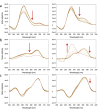A core extended naphtalene diimide G-quadruplex ligand potently inhibits herpes simplex virus 1 replication
- PMID: 28539620
- PMCID: PMC5443766
- DOI: 10.1038/s41598-017-02667-3
A core extended naphtalene diimide G-quadruplex ligand potently inhibits herpes simplex virus 1 replication
Abstract
G-quadruplexes (G4s) are nucleic acids secondary structures, epigenetic regulators in cells and viruses. In herpes simplex virus 1 (HSV-1)-infected cells, G4s are massively present during viral replication. We here aimed at investigating the possibility to target the HSV-1 G4s by a core extended naphtalene diimide (c-exNDI) G4 ligand. Biophysical and biomolecular analysis proved that c-exNDI stabilized the HSV-1 G4s in a concentration dependent manner. In MS competition assays, c-exNDI preferentially recognized HSV-1 G4s over cellular telomeric G4s, the most represented G4s within cells; other less abundant cellular G4s were also recognized. Treatment of HSV-1 infected cells with c-exNDI at low nanomolar concentrations induced significant virus inhibition with no cytotoxicity. The mechanism of action was ascribed to G4-mediated inhibition of viral DNA replication, with consequent impairment of viral genes transcription. Our data suggest that the observed potent antiviral activity and low cytotoxicity mainly depend on a combination of c-exNDI affinity for HSV-1 G4s and their massive presence during infection. HSV-1 G4s may thus represent new effective antiviral targets: the fact that no current antiherpetic drug exploits them and their presence at the viral genome, responsible for both active and latent HSV infections, makes them particularly attracting.
Conflict of interest statement
The authors declare that they have no competing interests.
Figures





Similar articles
-
Antiviral Activity of the G-Quadruplex Ligand TMPyP4 against Herpes Simplex Virus-1.Viruses. 2021 Jan 28;13(2):196. doi: 10.3390/v13020196. Viruses. 2021. PMID: 33525505 Free PMC article.
-
Visualization of DNA G-quadruplexes in herpes simplex virus 1-infected cells.Nucleic Acids Res. 2016 Dec 1;44(21):10343-10353. doi: 10.1093/nar/gkw968. Epub 2016 Oct 27. Nucleic Acids Res. 2016. PMID: 27794039 Free PMC article.
-
Effective deploying of a novel DHODH inhibitor against herpes simplex type 1 and type 2 replication.Antiviral Res. 2021 May;189:105057. doi: 10.1016/j.antiviral.2021.105057. Epub 2021 Mar 11. Antiviral Res. 2021. PMID: 33716051
-
Unlocking G-Quadruplexes as Antiviral Targets.Pharmacol Rev. 2021 Jul;73(3):897-923. doi: 10.1124/pharmrev.120.000230. Pharmacol Rev. 2021. PMID: 34045305 Review.
-
An insight into G-quadruplexes: Identification and potential therapeutic targets in livestock viruses.Eur J Med Chem. 2024 Dec 5;279:116848. doi: 10.1016/j.ejmech.2024.116848. Epub 2024 Sep 4. Eur J Med Chem. 2024. PMID: 39255642 Review.
Cited by
-
G-Quadruplexes: More Than Just a Kink in Microbial Genomes.Trends Microbiol. 2019 Feb;27(2):148-163. doi: 10.1016/j.tim.2018.08.011. Epub 2018 Sep 14. Trends Microbiol. 2019. PMID: 30224157 Free PMC article. Review.
-
Roles of G4-DNA and G4-RNA in Class Switch Recombination and Additional Regulations in B-Lymphocytes.Molecules. 2023 Jan 24;28(3):1159. doi: 10.3390/molecules28031159. Molecules. 2023. PMID: 36770824 Free PMC article. Review.
-
Naphthalene Diimides as Multimodal G-Quadruplex-Selective Ligands.Molecules. 2019 Jan 24;24(3):426. doi: 10.3390/molecules24030426. Molecules. 2019. PMID: 30682828 Free PMC article. Review.
-
Identification of G-quadruplex forming sequences in three manatee papillomaviruses.PLoS One. 2018 Apr 9;13(4):e0195625. doi: 10.1371/journal.pone.0195625. eCollection 2018. PLoS One. 2018. PMID: 29630682 Free PMC article.
-
G-quadruplexes and G-quadruplex ligands: targets and tools in antiviral therapy.Nucleic Acids Res. 2018 Apr 20;46(7):3270-3283. doi: 10.1093/nar/gky187. Nucleic Acids Res. 2018. PMID: 29554280 Free PMC article. Review.
References
Publication types
MeSH terms
Substances
Grants and funding
LinkOut - more resources
Full Text Sources
Other Literature Sources

